Nine papers from CS researchers are part of SIGGRAPH 2018
Researchers from the Columbia Computer Graphics Group will present at SIGGRAPH 2018. The 45th SIGGRAPH Conference highlights the latest research on computer graphics and interactive techniques with a technical papers program.
A Multi-Scale Model for Simulating Liquid-Fabric Interactions
Authors:
Yun (Raymond) Fei Columbia University, Christopher Batty University of Waterloo, Eitan Grinspun Columbia University, Changxi Zheng Columbia University
Picture coffee splashing onto upholstery spreads, dampening a larger area or how board shorts drag along with ocean waves, often buoyant, and drip distinctively – each interaction depends on the type of liquid and fabric involved. This is the problem that researchers set out to understand by creating a computational model that captures these varied liquid-fabric interactions.
“During WWII, people developed the theory of mixture to design solid dams.” said Raymond Fei, a PhD student and the paper’s lead author. “Nowadays, we found the same theory can also be used to describe the dynamics of wet fabrics and produce compelling visual effects.”
Developability of Triangle Meshes
Authors:
Oded Stein Columbia University, Eitan Grinspun Columbia University, Keenan Crane Carnegie Mellon University
Surfaces that are smooth and that can be flattened onto a plane are known as developable surfaces. These are important because they are easy to manufacture via bending material, or with certain CNC mills. The graphic on the left is an approximation example: The first shape is an arbitrary input surface in the shape of a guitar body. The team developed an algorithm to approximate it by a piecewise developable surface (middle). The right shows how that surface would look like as a guitar.
“There is a lot of interesting math in the problem of developable surfaces,” said Oded Stein, the lead author. Many concepts from smooth mathematics don’t directly translate to the discrete world of triangle meshes. In smooth mathematics, a surface is developable if it has zero curvature. He continued, “But if we simply discretize the curvature at every point in the discrete surface, we get ugly, crumpled results unsuitable for fabrication. We had to rethink what it means to be developable, and transfer this concept to the discrete world.”
Natural Boundary Conditions for Smoothing in Geometry Processing
Authors:
Oded Stein Columbia University, Eitan Grinspun Columbia University, Max Wardetzky, Universität Göttingen, Alec Jacobson University of Toronto
In many problems in geometry processing, such as smoothing, the biharmonic equation is solved with low-order boundary conditions. This can lead to heavy bias of the solution at the boundary of the domain. By using different, higher-order boundary conditions (the natural boundary conditions of the Hessian energy), the results are unbiased by the boundary.
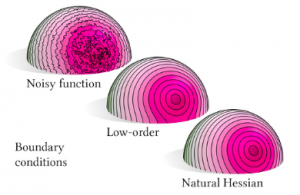
Using the Hessian as the basis for smoothness energies, this paper derives methods for animation, interpolation, data denoising, and scattered data interpolation.
“We were surprised by how many things this potentially applies to – the biharmonic equation is solved all over computer graphics whenever researchers ‘square the cotangent Laplacian,’ one of the common operators in computer graphics,” said Stein. “Many of these applications could avoid bias at the boundary by using the natural boundary conditions of the Hessian energy instead.”
Multi-Scale Simulation of Nonlinear Thin-Shell Sound with Wave Turbulence
Authors: Gabriel Cirio Inria, Université Côte d’Azur, Columbia University, Ante Qu Stanford University, George Drettakis Inria, Université Côte d’Azur, Eitan Grinspun Columbia University, Changxi Zheng Columbia University
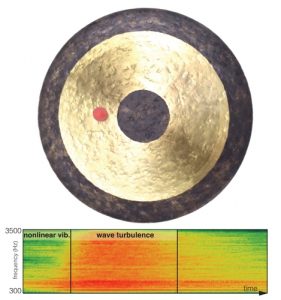
This paper is about generating the sound that virtual thin shells – such as cymbals and gongs – make when they are struck, by modeling and simulating the physics of elastic deformation and vibration using a computer.
If an animator has a sequence of a water bottle falling and hitting the ground, their model can automatically produce the corresponding sound, perfectly synchronized with the visuals and without requiring real recordings. With this technique, one can also generate the sound of virtual instruments such as a cymbal or a gong.
“It was surprising how complex something as simple as striking a cymbal can be,” said Gabriel Cirio, the lead author on the paper and post doctoral fellow at Columbia. The team turned to phenomenological models of turbulence, that capture the overall behavior instead of precisely simulating every vibration in the shell. Cirio further shared,”The resulting sounds are rich, expressive, and could easily be mistaken for a real recording.”
Scene-Aware Audio for 360° Videos
Authors:
Dingzeyu Li Columbia University, Timothy Langlois Adobe, Changxi Zheng Columbia University
“It was very challenging to make sure the synthesized audio blends in seamlessly with the recorded sound,” said Dingzeyu Li, the lead author from Columbia University. Given any input in 360° videos, the team was able to edit and manipulate the spatial audio contents that match the visual counterpart. He continued,”I am glad that we found a frequency modulation method to bridge the gap between virtually simulated and real-world audios, compensating for the room resonance effects.”
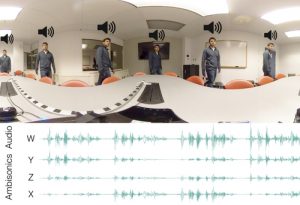
One application would be to augment existing 360° video with only a mono-channel audio. If a viewer were to watch this video, the audio would not adapt to the view direction dynamically since the mono-channel audio does not contain any spatial information. The team developed a method that can augment this video by synthesizing the spatial audio. This augmentation idea has been used before, for example to convert 2D movies shot in the early days to 3D formats. In this case, the 360° videos with only mono-channel audio are converted to ones with immersive spatial audio with a richer sound.
What Are Optimal Coding Functions for Time-of-Flight Imaging?
Authors:
Mohit Gupta University of Wisconsin-Madison, Andreas Velten University of Wisconsin-Madison, Shree Nayar Columbia University, Eric Breitbach University of Wisconsin-Madison
This paper presents a geometric theory and novel designs for time-of-flight 3D cameras that can achieve extreme depth resolution at long distances, sufficient to resolve fine details such as individual bricks in a building, even in a large, city-scale 3D model, or fine facial features needed to recognize a person’s identity from a long distance.

“Time-of-flight cameras have been around for nearly four decades now, and are fast moving towards mass adoption,” said Mohit Gupta, a former postdoc at Columbia now based at the University of Wisconsin-Madison. “We were surprised that almost all the cameras so far have been based on a particular design, which our new designs could out perform almost by an order-of-magnitude.”
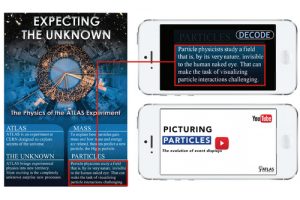 FontCode: Embedding Information in Text Documents Using Glyph Perturbation
FontCode: Embedding Information in Text Documents Using Glyph Perturbation
Authors:
Chang Xiao Columbia University, Cheng Zhang UC Irvine, Changxi Zheng Columbia University
Researches used a method based on a 1500 year old theorem called Chinese Remainder Theorem to develop an information embedding technique for text documents.
“Changing any letter, punctuation mark, or symbol into a slightly different form allows you to change the meaning of the document,” said Chang Xiao, in an interview. “This hidden information, though not visible to humans, is machine-readable just as bar and QR codes are instantly readable by computers. However, unlike bar and QR codes, FontCode won’t mar the visual aesthetics of the printed material, and its presence can remain secret.”
Interactive Exploration of Design Trade-Offs
Authors:
Adriana Schulz MIT, Harrison Wang MIT, Eitan Grinspun Columbia University, Justin Solomon MIT, Wojciech Matusik MIT
“Our method allows users to optimize designs based on a set of performance metrics,” said Adriana Schulz, a graduate student from the Massachusetts Institute of Technology. Given a design space and a set of performance evaluation functions, our method automatically extracts the Pareto set—those design points with optimal trade-offs.”

Schulz continued, we represent Pareto points in design and performance space with a set of corresponding manifolds (left). The Pareto-optimal solutions are then embedded to allow interactive exploration of performance trade-offs (right). The mapping from manifolds in performance space back to design space allows designers to explore performance trade-offs interactively while visualizing the corresponding geometry and gaining an understanding of a model’s underlying properties.
FoldSketch: Enriching Garments with Physically Reproducible Folds
Authors:
Minchen Li The University of British Columbia, Alla Sheffer The University of British Columbia, Eitan Grinspun Columbia University, Nicholas Vining The University of British Columbia
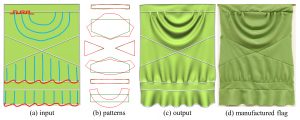
Complex physically simulated fabric folds generated using FoldSketch: (left to right) Plain input flag with user sketched schematic folds (a), original (green) and modified final (red) patterns (b); final post-simulation flag augmented with user-expected folds (c); real-life replica manufactured using the produced patterns (d).
FoldSketch allows designers to add folds to a garment via schematic annotation strokes. “We had to apply novel computational optimization and numerical simulation techniques to solve shape modeling and animation problems,” said Minchen Li, the lead author from The University of British Columbia. “The result is a new system that produces garment patterns that facilitate the formation of the desired folds on real and virtual garments.”

